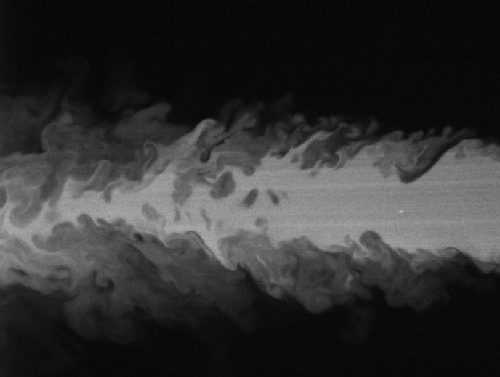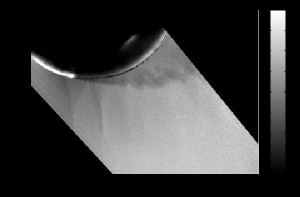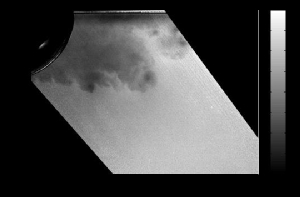Planar Density Measurements Using Acetone PLIF
-
Students: Zach Reid and Kyle Lynch
-
Funding Agency: Air Force Office of Scientific Research
Acetone PLIF in a non-intrusive flow visualization technique that uses ultraviolet light to excite and fluoresce acetone molecules in a flow field. A thin Nd:YAG laser sheet is shined through a flow field that is seeded with acetone molecules. A fraction of the seeded acetone molecules fluoresce at a higher wavelength (wavelength range - about 350-550nm). This fluorescence can be collected by a CCD and images of this flow field can be obtained. Image processing is then performed. Not only can acetone PLIF images provide qualitative information about the flow field, but they also can provide quantitative information such as density, pressure, temperature, and velocity. The Advanced Laser Diagnostics Laboratory is only using acetone PLIF to obtain density information.

Single-Shot Acetone PLIF Image of a Low-Speed Jet
The application of a planar density measurement technique for compressible flow fields based on acetone planar laser induced fluorescence (PLIF) is presented. An error analysis indicates a minimum inherent uncertainty of approx. 2.5% in density measurements due to uncertainty in local pressure and a total experimental uncertainty of 8%, primarily driven by shot noise due to low signal levels. The technique is demonstrated through the visualization of the separated shear layer and turbulent wake of a wall-mounted hemisphere at a freestream Mach number of 0.78 and Reynolds number of approximately 900,000. The flow is marked by large-scale flapping motion of the wake and low-density vortex cores where density drops of up to 50% of the freestream density are detected. In addition, close-up images of the shear layer near the separation point reveal the formation of lambda shocks. The density fields are used to perform aero-optic distortion calculations through spatial integration of the density field. A correlation is found between the spatial scale of the distortion and the features present in the density field. These findings demonstrate the viability of acetone PLIF for conducting planar density measurements and provide a new method for the evaluation of aero-optic distortion in compressible flows.
|
|
 |
 |
 |
|
|
 |
Examples of planar density measurements obtained using the acetone PLIF technique.
For more information, please see:
- Reid, J., Lynch, K. and Thurow, B., “Density Measurements of a Turbulent Wake using Acetone PLIF,” accepted for publication in AIAA Journal, 2013.





